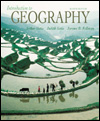 |  Introduction to Geography, 8/e Arthur Getis,
San Diego State University
Judith Getis
Jerome D. Fellmann,
University of Illinois, Urbana-Champaign
Population Geography
ProblemsWeb Page Questions:
Answer the following questions using the web pages listed in the chapter.
- Population Reference Bureau - http://www.prb.org
When will India surpass China in total population? ________________________________________________ - Select the "US in the World" option. Find your state and its corresponding
country.
What are the common characteristics which link these two regions? __________________________________________________________________________________________
__________________________________________________________________________________________
__________________________________________________________________________________________
__________________________________________________________________________________________
Problems:
1. The population pyramid is used to provide a visual impression of the age
and sex composition of a country's population. A country's population by age
and sex cohorts is provided in the following table. In order to construct the
population pyramid:
- Calculate the percentage of the total population for each sex and age cohort.
- Construct the population pyramid on the diagram provided.
- Referring to the population pyramids given in your text, which one resembles
the constructed pyramid? ___________________________________________
- What is the total percentage of?
- males? _______________
- females? _______________
- What is the total percentage of dependents in the population? _______________
| Age | Males | Percent | Females | Percent | |
0 - 4
|
1,911,500
| |
1,890,800
| | |
5 - 9
|
1,884,900
| |
1,884,900
| | |
10 - 14
|
1,797,700
| |
1,700,700
| | |
15 - 19
|
1,913,300
| |
1,813,700
| | |
20 - 24
|
2,281,800
| |
2,202,300
| | |
25 - 29
|
2,395,900
| |
2,343,700
| | |
30 - 34
|
2,120,300
| |
2,104,800
| | |
35 - 39
|
1,896,000
| |
1,893,900
| | |
40 - 44
|
2,070,300
| |
2,071,800
| | |
45 - 49
|
1,758,400
| |
1,760,800
| | |
50 - 54
|
1,533,100
| |
1,540,900
| | |
55 - 59
|
1,445,000
| |
1,474,900
| | |
60 - 64
|
1,392,800
| |
1,500,500
| | |
65 - 69
|
1,291,000
| |
1,502,500
| | |
70 - 74
|
982,800
| |
1,298,800
| | |
75 - 79
|
727,000
| |
1,136,200
| | |
80+
|
649,400
| |
1,496,100
| |
- Total males _________
- Total females _________
- Total population _________
 <a onClick="window.open('/olcweb/cgi/pluginpop.cgi?it=gif::Age Chart::/sites/dl/free/0072367229/9466/Image06_01.gif','popWin', 'width=448,height=505,resizable,scrollbars');" href="#"><img valign="absmiddle" height="16" width="16" border="0" src="/olcweb/styles/shared/linkicons/image.gif">Age Chart (186.0K)</a>Age Chart <a onClick="window.open('/olcweb/cgi/pluginpop.cgi?it=gif::Age Chart::/sites/dl/free/0072367229/9466/Image06_01.gif','popWin', 'width=448,height=505,resizable,scrollbars');" href="#"><img valign="absmiddle" height="16" width="16" border="0" src="/olcweb/styles/shared/linkicons/image.gif">Age Chart (186.0K)</a>Age Chart2. Using Figure 6.17, Stages in the Demographic Transition, and
the crude birth and death rates from the Appendix, place each of the
following countries into its appropriate demographic stages. | Region | Birth Rate | Death Rate | Natural Increase | Stage in Cycle | |
Morocco
| | | | | |
New Zealand
| | | | | |
Ethiopia
| | | | | |
Qatar
| | | | | |
Malta
| | | | | |
Laos
| | | | | |
Costa Rica
| | | | | |
Germany
| | | | | |
Bulgaria
| | | | | |
Paraguay
| | | | |
3. Using the Appendix, for each of the following population characteristics,
list the top five and bottom five ranking countries.
a. Natural Increase
b. Infant Mortality
c. Total Life Expectancy
d. Fertility Rates
Critical Thinking Questions - Explain how population pyramids can be used to plan for the needs of a country's
population 20-50 years into the future. Give an example using the need to
provide a population with social services.
- Discuss the statement "Famine has always been a region's natural population
control."
- Suppose that you are the head of a space exploration agency from a planet
many light years from Earth. The long-range sensors on the probe you directed
into the Earth's solar system has mapped the third planet from the sun using
scanners sensitive enough to map Earth's surface features. Analyzing the data,
you decide NOT to send a landing party to Earth. Why?
- In your capacity as a researcher for a consulting company, you have been
given the task of suggesting ways to alleviate an overpopulation problem on
an island in a developing country. Discuss in detail two research methods
you would use to assess the situation on the island and two options you would
present to your client to alleviate the situation. For each research method
tell why you would select it and the type of information it would provide.
For each option, tell why it is workable and within what approximate time
frame (short term/medium term/long term) each one would have an effect.
- In your capacity as a researcher for a consulting company, you have been
given the task of assessing whether an island of Indonesia is suitable for
the relocation of 15,000 people. Discuss in detail two research methods you
would use to gather information about the island and two environmental factors
that must be taken into consideration as part of your assessment.
|
|



 2002 McGraw-Hill Higher Education
2002 McGraw-Hill Higher Education

 2002 McGraw-Hill Higher Education
2002 McGraw-Hill Higher Education